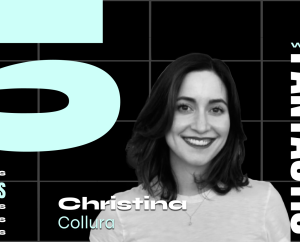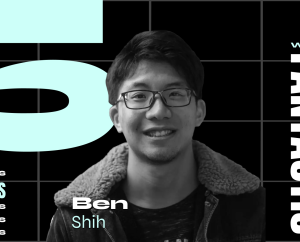Para leer este artículo en español, entra acá.
Arturo is a leader in experience design, and for more than 7 years, he has specialized in design and digital products.He was a founding member of different intra-ventures at BCP. As part of BCP’s Strategic Design COE, he currently leads the team of designers located in BCP’s Innovation and Disruption units, creating new scalable products and services for more than 30 million people. In his spare time, Arturo explores new specialty coffee shops with his 4-legged companion while listening to math rock.
Cinthy is a Senior Design Manager in charge of developing Specialties and Specialist Talent in the BCP Strategic Design COE, as well as Design projects for the Corporate front of the Credicorp Group. She collaborates closely with senior executives and Design leaders to enhance strategic design capabilities, optimize design processes, and standardize practices for creating Wow digital products. Additionally, she is a Design and Innovation Corporate Coach, providing advice to design, digital transformation, agility and innovation teams and leaders in companies such as MiBanco, Pacifico, CapitalLab and BCP Bolivia.
In 2015, Banco de Crédito del Perú (BCP) initiated a comprehensive transformation process on its 126th anniversary, gearing up for the upcoming 130 years. Despite being a financial institution that has navigated through governments and crises, it now serves approximately a third of the Peruvian population. The digital transformation marked a significant shift, leading to the establishment of an innovation center and groundbreaking hires of UX and UI designers, along with professionals in product ownership and development. Despite notable successes like the design of Yape and the digital wallet, there was a recognized need for a more strategic approach as the team often found itself constrained by tactical expectations. This journey reflects BCP’s ongoing evolution in its commitment to change, digitize processes, and enhance the customer experience.
In 2018, we experienced rapid growth by expanding into new organizational units to tackle strategic challenges, engaging in wholesale banking, and overseeing digital channels, including the mobile application. As we solidified ourselves as a Center of Excellence (COE), we observed our growth stabilizing, acknowledging that everything has a limit. Although we were comfortable with this perspective and ready to strengthen our foundations after scaling from 10 to 150 designers in three years, the pandemic and local crises led to frequent shifts in the bank’s objectives in pursuit of sustainable growth. This resulted in increased team turnover due to more accessible remote work for foreign companies, and the team’s satisfaction regarding their development as designers did not meet expectations.
After 8 years, the team’s primary investor posed a question we believed was resolved: What is the value of design? This query, raised by our key stakeholder, served as a painful reminder of the need to demonstrate the profitability of design and its positive impact on organizational goals. Internal and external crises underscored the importance of forging connections, and other stakeholders requested greater involvement of design in business matters. Upon reflection, we acknowledged that our collaboration and development were ineffective in fostering a smooth dialogue with the business team. Despite focusing on daily challenges, we lacked a strategic, long-term perspective. Recognizing the need for a change in the formula, we embarked on a revisit of our foundations, specifically in career maps and specialized talent development that once defined our trajectory. The evolution of these elements, aligned with the team’s vision, has laid the groundwork for how design can contribute to the bank’s purpose: transforming plans into reality.
Rebuilding Our Career Maps
Career maps play a crucial role in design teams, providing comprehensive guidance that benefits both individual professionals and the organization as a whole. They offer clarity and direction by transparently outlining the opportunities and trajectories available for professional development in the field of design. This clarity is essential for designers to understand their current position, visualize possible advancements, chart a course towards their long-term goals, and clearly identify how it connects with their contribution to the organization. These maps are essential for professional development, highlighting training opportunities and areas of specialization that allow designers to acquire the necessary skills to advance in their roles. This structured approach not only fosters individual growth but also contributes to the collective development of skills within the team.
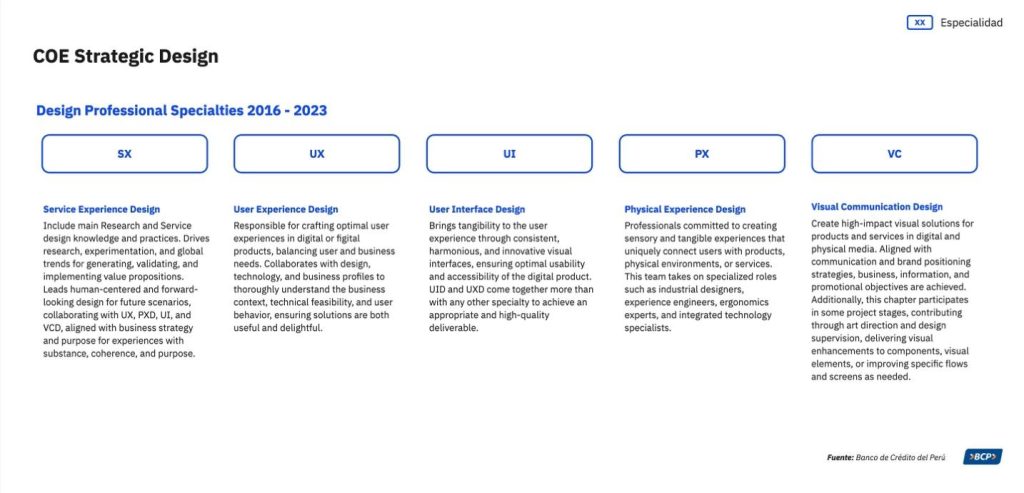
Talent retention is enhanced through clearly defined progression paths and support for personal and professional growth, decisive factors for designers choosing to stay in an organization, fostering more stable teams. By visualizing development opportunities, these elements drive designers’ commitment to their roles and projects, cultivating a collaborative and motivating environment. The flexibility of career maps, adaptable to changing team needs and industry dynamics, allows professionals to stay relevant and resilient to changes. Including leadership trajectories in these career maps promotes the development of internal leaders, essential for the sustainable growth of teams and their ability to lead projects effectively.
To achieve all these benefits, we took a different approach, considering various perspectives: the needs of the company, the team, and the Design Organization. We allowed ourselves to delve into a “big picture” view, not just from within, including the perspectives of our different designers on the team, but also from outside the design organization. We engaged with stakeholders to whom we provided our design services, benchmarked companies that are industry leaders, and consulted with international professionals who would later become our allies in building these maps.
We started with small steps, first defining a set of skills that each UX, UI, Research, and Service designer should have. We investigated new specialties and skills that were relevant to big tech companies. We delved into understanding the pains in the design process, identifying areas for improvement, and growth opportunities. This approach allowed us not only to establish a solid foundation of essential skills but also to anticipate and adapt to the changing demands of the work environment and market expectations. However, we quickly identified several aspects that we had not addressed, with the main one being that we continued to view specialties as silos.
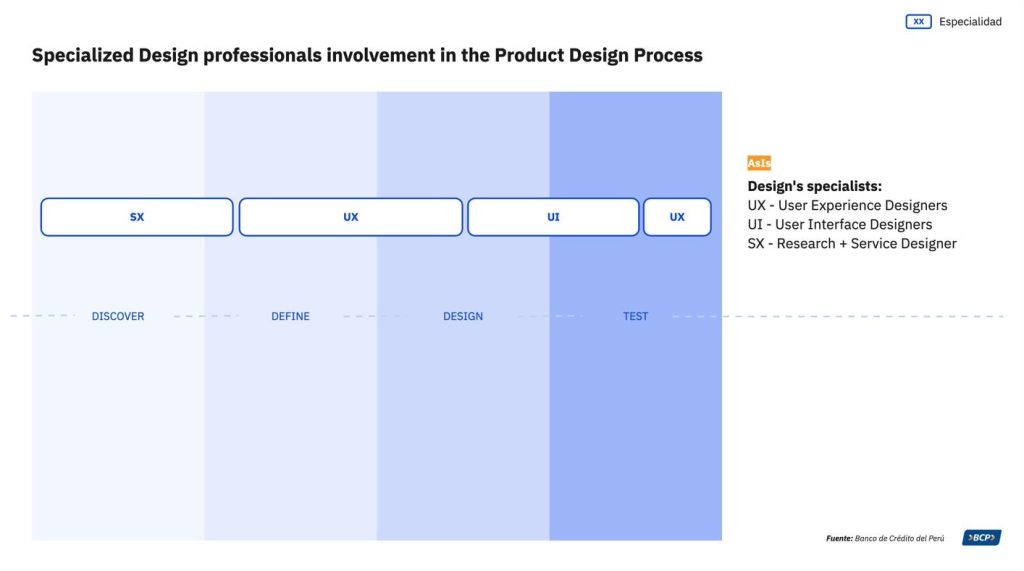
We also identified that the leadership line in design was being overlooked, and the growth path for managers was not being addressed. The lack of recognition of this crucial direction affected the team’s cohesion and its ability to advance effectively. The importance of the leadership role in design not only lay in general supervision but also in its function to foster the growth and development of team members. Without adequate attention to this dimension, problem-solving and innovation were being hindered. And not only in leaders but also in the ownership capacity that each team member should have. Addressing both aspects would not only strengthen the team’s structure but also catalyze a more effective dynamic and successful execution of design projects.
We gathered feedback from the team and analyzed how different companies of smaller, equal, and larger sizes than ours had designed growth paths for each specialty. Buzzfeed, Figma, GitLab, IBM, Intercom, among others, were our main references. With all this, and after the analysis, we identified the three key problems to solve:
- We want to foster synergies and enhance the value of design. What can we do to have a cross-specialty perspective? This resulted in two ideas: creating cross-functional capabilities among teams and enhancing the focus on the space where specialties intersect in their involvement in the design process.
- How can we integrate capabilities related to the business and the organization we serve, and how do we make this intentional learning happen? To address this, we identified the capabilities that could help us develop these additional skills in designers.
- How do we stay current and flexible with new knowledge and skills? If we are in an environment of constant innovation and transformation, shouldn’t we be flexible and open to new technologies and changes in our context? This led to a set of dimensions to help us classify.
We got down to work
To tackle this problem, we set out to develop a talent architecture, the logic of which lies in creating a framework that incorporates equal dimensions for all specialties, acting as capacity groupers. These capacities could be of two types. First, there are the transversal dimensions, which cut across different specialties and aim to generate synergies in the learning and actions of designers, promoting a comprehensive view of the design process from start to finish. In contrast, ad-hoc dimensions are specific to each specialty. Each capacity in these dimensions groups key knowledge skills, and each capacity is linked to specific behaviors. This comprehensive approach allows for a flexible and collaborative structure, fostering excellence in both specialized skills and skills that span multiple disciplines, thus supporting a holistic and efficient approach to talent development in design.
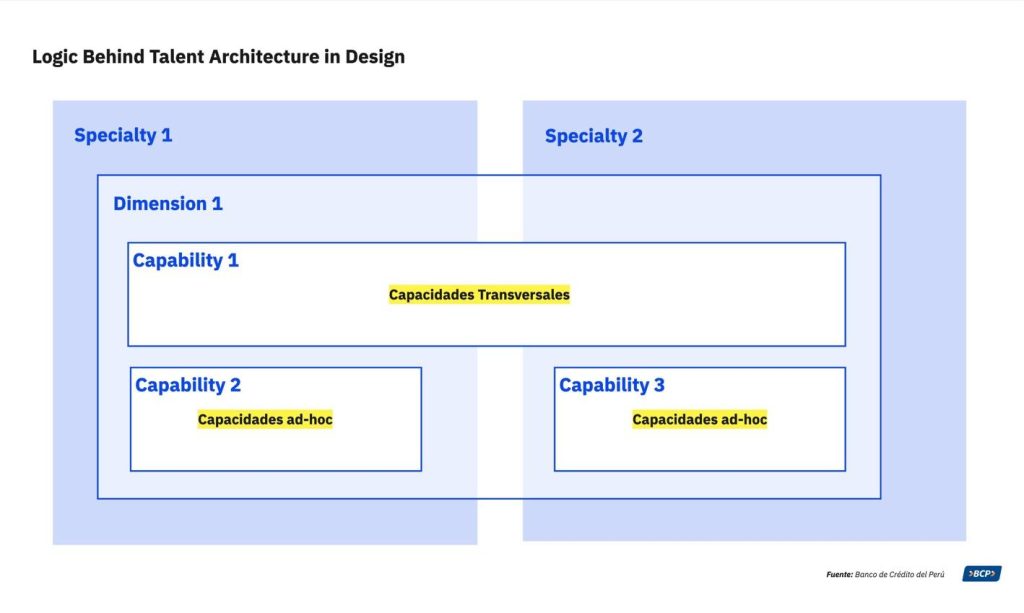
We then formed an internal team with some of the best designers from the three specialties we would redesign, and we began co-creating the set of capacities and skills that each UX designer, UI designer, and Service Designer should have. We spent three months researching, advancing, and retreating to reach the first proposal. The process led us to have an average of 18 capacities and 90 skills per specialty. We developed capacities such as interaction design, motion design, hand-off, art direction, information architecture, accessibility and inclusion, among others. Additionally, we proposed the concept of transversal capacities: a set of capacities that all three specialties would have in common, such as design research, design management, design leadership, and business knowledge.
At the end of the process, the framework worked, but when delving into the details of the UX, UI, and SXD specialties, we had several surprises, with the main one being the feedback. Although it was an evolution, it wasn’t as aligned with growth and challenge expectations. We realized that we were repeating some mistakes and facing the same challenges, but in a slightly different way. At that moment, we decided, in the words of our design leader, to stop. We paused and acknowledged that we needed a fresh perspective because it was no longer just an upgrade but a complete redesign, as this had been the only thing we hadn’t managed to break (our “riskiest assumption”). We were clear at that moment that we needed help to go a step further to break down silos between specialties.
It was then, after talking to more than 20 top professionals from various Fortune50 companies, that we found a duo that could help us. Chloe Gottlieb and Wayne Robins, former design directors at Google, were the chosen ones.
We talked to them about the challenges we had in the organization and what we were doing to address them. We realized they were the right partners when they brought up the idea that perhaps it was time to rethink our specialties from the ground up and also develop a line for design leaders.
After a few months of joint work, we arrived at our new specialties: Product Design, Design Research, and Service Design, with a key contribution to enhancing the contribution of each specialty with a more end-to-end perspective, breaking down silos between specialties and collaborating in each unit, project, and product holistically.
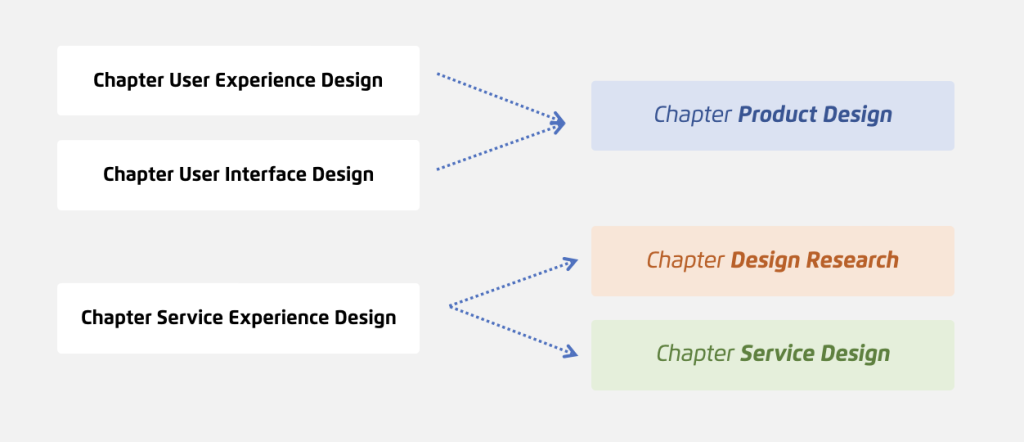
We took the learnings and skills from UX and UI, and integrated them, along with many more, into Product Design. And for the case of SXD, we decided to focus and delve into the capabilities that each one could bring to the table.
Finally, all of this led us to our new paradigms:
- The practice of Design as a cross-cutting base for all specialties.
- Simplifying specialties by giving them a greater focus.
- Enhancing synergies between them to increase productivity and satisfaction.
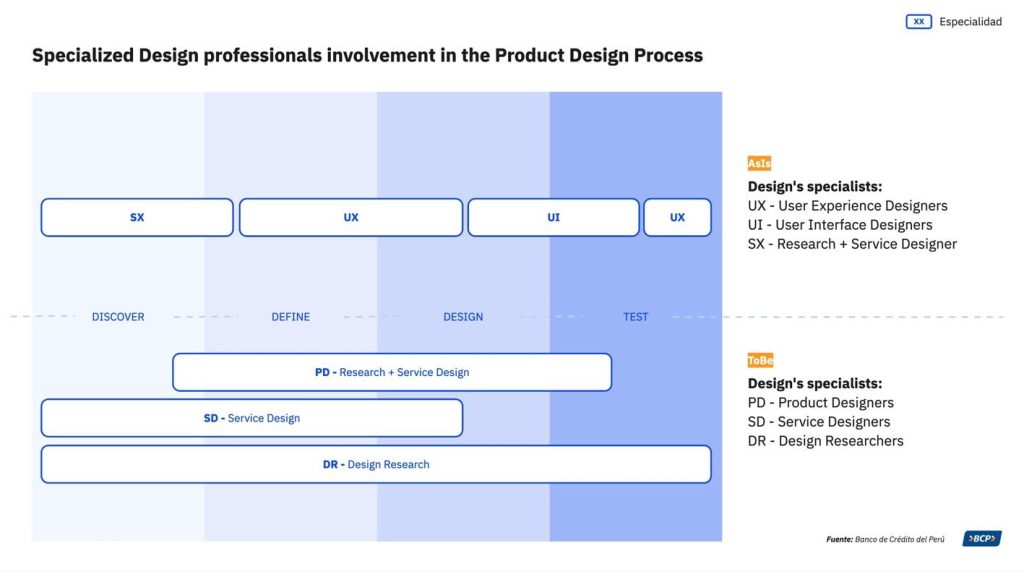
On the verge of a recession in the country, we couldn’t be happier that we are on the right path. We take away a great lesson and have much to do as we fulfill our commitment to design talent development. Today, we understand with certainty that the approaches that got us here may not necessarily be the ones to lead us to where we want to go: steering the bank’s experience through design, humanizing it, and turning plans into realities for millions of Peruvians. Always mindful that what we’ve achieved so far is just the first step.
Cinthy and Arturo will give a talk titled “How to transform a bank that is more than 130 years old into a design-led organization? at the Design Matters Mexico 24 conference, in Mexico City and online on Jan 31 – Feb 1, 2024 . Get your tickets at designmatters.mx or visit DesignMattersPluis.io after the conference to enjoy their recorded talk.





